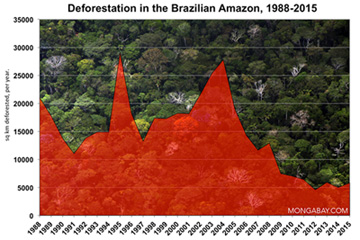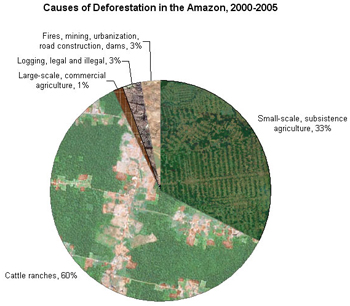Amazon deforestation rate plunges 41 percent
Amazon deforestation rate plunges 41 percent
mongabay.com
October 26, 2006
Today the Brazilian government announced a sharp drop in Amazon deforestation.
Forest loss for the 2005-2006 year was 13,100 square kilometers (5,057 square miles) of rainforest, down more than 40 percent from last year. The figure is the lowest since 1991 when 11,130 square kilometers (4,258 square miles) of forest were lost.
Last month the government announced 16,700 square kilometers (6,450 square miles) of forest had been lost this year, but revised the figures after additional data was analyzed.
Deforestation peaked in 1995 when 29,059 square kilometers (11,219 square miles) of forest were cut. Deforestation has plunged by almost 50 percent since 2004. Falling commodity prices, increased enforcement efforts, and government conservation initiatives are credited for the drop.
“We aggressively increased enforcement of environmental laws in the past years and it has worked,” Joao Paulo Capobianco, Brazil’s minister-secretary of biodiversity and forests, told the Associated Press.

DEFORESTATION IN BRAZIL: 60-70 percent of deforestation in the Amazon results from cattle ranches while the rest mostly results from small-scale subsistence agriculture. Logging results in forest degradation but rarely direct deforestation. However, studies have showed a close correlation between logging and future clearing for settlement and farming. Graphic by R. Butler. |
In the past four years Brazil has set aside more than 100 million hectares of the Amazon basin from development. The country now has some 173 million hectares of forest, an area nearly three times the size of France, under some form of protection, giving it the largest protected areas system in the world. At the same time the government has aggressively gone after illegal loggers and land developers in the region. According to the ministry of biodiversity and forests, more than 400 have been arrested, $1.3 billion in fines levied, and 28 million cubic feet of wood seized in enforcement operations over the past four years. Some of the arrests have been among agents of the federal environmental protection agency where corruption has historically been a problem. In total the government has spent about $93 million fighting deforestation according to the ministry.
While the government has been quick to take credit for the drop in deforestation, analysts say declining commodity prices have played a key part in reducing forest clearing rates. Most recent deforestation in the Amazon results from agricultural expansion, especially among cattle ranchers, large-scale soybean producers, and subsistence farmers. A study published last month by NASA researchers showed that forest clearing for large-scale agriculture has recently become a significant cause of deforestation in the Brazilian Amazon. The study, published online in the September 14, 2006 edition of the Proceedings of the National Academy of Sciences (PNAS), found that in 2003 — when some 24,130 square kilometers of forest were lost across the Amazon — more than 20 percent of the forests in the state of Mato Grosso were converted to cropland, suggesting that the recent expansion of mechanized cropland in the region is contributing significantly to deforestation.
The PNAS findings seemed to confirm the suspicion that Brazil’s soybean production is impacting the Amazon and followed a controversial Greenpeace report which accused fast-food chain McDonald’s of underwriting deforestation in the Amazon through its purchase of soy-based animal derived from soybeans grown in the Amazon Basin. The charges led the company to launch an investigation into Greenpeace’s claims and helped trigger a two-year moratorium by Brazilian soy crushers and exporters on trading soybeans grown on newly deforested lands in the Amazon basin.
 Causes of Amazon deforestation.
|
“Soy farming is having a huge impact in the Amazon right now, for three reasons,” said William F. Laurance, president of the Association for Tropical Biology and Conservation (ATBC) and a senior staff scientist at the Smithsonian Tropical Research Institute, in an earlier interview with mongabay.com. “First, industrial soy farmers are themselves clearing a lot of forest. Second, soy farmers are buying up large expanses of cleared land from slash-and-burn farmers and cattle ranchers, and the displaced farmers and ranchers often just move further out into the forest, maintaining a lot of pressure on frontier areas. Finally, the soy farmers are a very powerful political lobby that is pushing for major expansion of roads, highways, river-channelization projects, and other transportation that will criss-cross large expanses of the Amazon. This infrastructure is acting like Pandora’s box–it is opening up the frontier to spontaneous, unplanned colonization and exploitation by ranchers, farmers, hunters, and illegal gold miners.”
Beyond agriculture, logging and infrastructure development also contribute to forest loss and degradation in the Amazon.
Climate change: the lurking risk
Scientists are increasingly concerned about the effect of global warming on the Amazon forest. While it’s unclear how higher global temperatures will impact the forest in the long-term, in recent years the Amazon have been plagued with devastating droughts that have stranded communities and fueled forest fires that damage the Amazon ecosystem. Some researchers believe much of the Amazon could become savanna before the turn of the century, a shift that could have a profound impact on local precipitation and weather patterns.
While industrial fossil fuel combustion is responsible for the bulk of greenhouse gas emissions, deforestation in the Amazon may account for 4-6 percent of total global emissions of such heat-trapping gases. In recognition of this, next month at climate talks in Nairobi Brazil is expected to propose a plan to seek compensation from industrialized countries for conserving its rainforests to fight global warming. The plan follows a similar initiative by a coalition of developing countries proposed last November at climate talks in Montreal.
“Avoided deforestation has great potential both in the struggle against global warming and as a means of maintaining Amazonian forest with all of its environmental services, of which carbon storage is only one,” Dr. Philip Fearnside, a Research Professor at the National Institute for Research in the Amazon in Manaus, told mongabay.com in an interview. “The proposals by the Coalition of Rainforest Nations and by Brazil’s Ministry of the Environment are certainly positive.”
“It’s potentially a win-win situation for everybody involved,” said Laurance in a statement earlier this year. “The forests win, the atmosphere wins, the international community wins, and developing nations struggling to overcome poverty win.”
The Amazon: Earth’s Largest Rainforst
 Monkey frog in Peru. Photo by Rhett A. Butler |
The Amazon is Earth’s largest rainforest. Some scientists estimate that perhaps 30 percent of the world’s land species are found in the Amazon. The bulk of Amazon rainforest is found in Brazil, which today houses about one-third of the world’s remaining rainforests.
The Amazon has experienced an exceptional extent of forest loss over the past two generations—an area almost certainly exceeding 600,000 square kilometers (232,000 square miles), or about 15 percent of its total surface area of 4,005,082 square kilometers, has been cleared in the Amazon since 1970, when only 2.4 percent of the Amazon’s forests had been lost. The increase in Amazon deforestation in the early 1970s coincided with the construction of the Trans-Amazonian Highway, which opened large forest areas to development by settlers and commercial interests. In more recent years, growing populations in the Amazon region, combined with increased viability of agricultural operations, have caused a further rise in deforestation rates. Since the close of the 1990s, annual deforestation rates of primary forest cover in Brazil have climbed by more than a third.
This article used information from an AP report as well as extensive excerpts from previous mongabay.com articles.